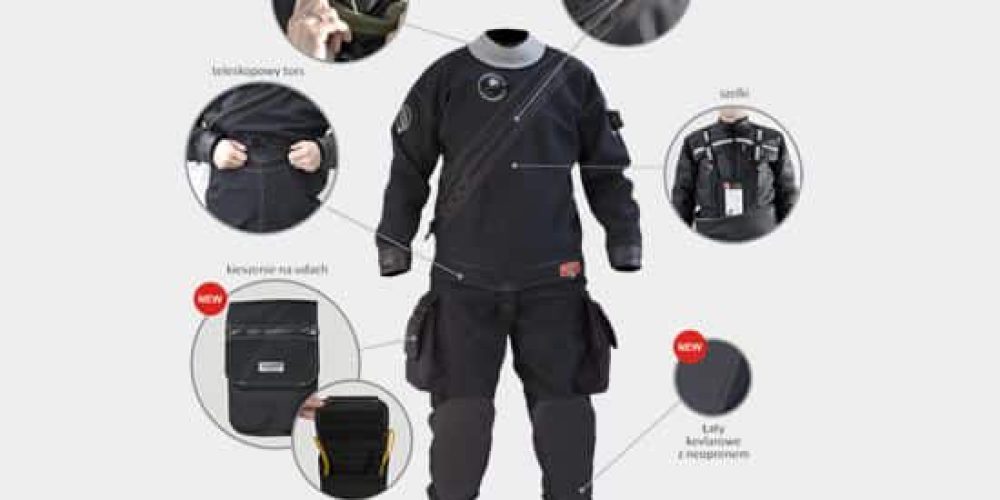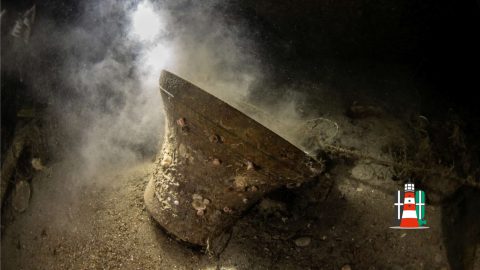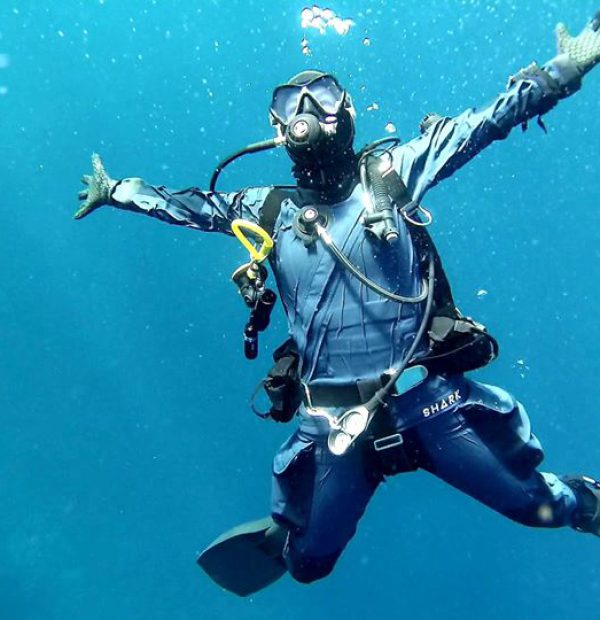Tuesday, 23 April 2024
Menu


photo:The Santi E.Lite wetsuit is currently the most technically advanced wetsuit available on the market.
Despite the simple function of a drysuit, it has many elements that we should know and understand well before making a choice. The variety of these elements means that different wetsuits work best in different conditions and it is difficult to choose the best one.
Material
The first and most important parameter of our future outfit is the material from which it will be made. Nowadays, each manufacturer offers a wide range of materials with various properties. All modern drysuits can be divided into two basic groups: neoprene and trilaminates.
Neoprene is a trade name for a synthetic rubber invented in 1931 by the American chemical company DuPont. In Poland, neoprene, synonymous with foam, is a common name for the material created by processing Neoprene, which results in gas bubbles being trapped in it. It used to be used in the production of dry suits but due to its thickness (approx. 5-7mm), it is now only a base for compressed neoprene which is much more suitable for the production of drysuits.
Very often compressed neoprene (compressd neoprene) is confused with crushed neoprene (crushed neoprene) which is a patent of the American manufacturer DUI.
Compressed neoprene, apart from its thickness, does not differ much from regular neoprene. The compression causes a reduction in the number and size of bubbles filling the material, which translates into a reduction in its thickness to about 3-4mm. Thanks to the compression, the neoprene changes its buoyancy to a lesser degree along with the depth you are at, which makes the dives safer. Wetsuits made of this material weigh less than normal neoprene, however, they are less flexible and have poorer thermal properties.
Crushed neoprene is created by subjecting neoprene to high temperatures and a pressure of 35 atmospheres. As a result of this process, gas bubbles are completely eliminated and the material itself becomes more durable and flexible. The lack of bubbles completely eliminates the phenomenon of buoyancy change.
The second group are trilaminates, which are materials made up of 3 different layers. They are sometimes called membrane suits. The common feature of all trilaminates is the middle layer which is butylene and the inner layer which is polyester. Depending on the function of the suit, the outer layer is made of nylon (350g/m2), cordura (600g/m2) or polyester (390g/m2). While in neoprene, the main parameter is its thickness, in trilaminates it is the weight. The greater the weight of the material per square metre, the greater the mechanical strength of our wetsuit.
The most durable trilaminates use cordura as a top layer. Nylon dryers, due to their light weight, are very light and flexible, so when rolled up they can fit even into a small backpack. This makes them very easy to transport, especially if we travel by plane.
When deciding on a material we have to find a compromise between weight, flexibility, strength and the thermal insulation the dryer will give. Neoprene wetsuits are the heaviest, but offer the best insulation against the cold. Another advantage is that they fit better to the body, which translates into less air that we have to let into the suit to achieve comfort. The advantage of multilayer materials is their low weight and high resistance to damage. In Polish waters, however, their lower thermal insulation in comparison to neoprene is clearly noticeable. Multilayer materials have very little stretch, which makes the suit look baggy when worn on the surface. This makes membrane suits easier to put on and less tiring to move around in before diving. It is also necessary for us to have a full range of movement underwater.
Cordura and crushed neoprene are considered to be the most durable and resistant materials. Wetsuits made of these materials are best suited for diving where the risk of damaging the suit is high. Wreck diving can be an example of such diving.
Castle
The gas-tight zip is the most expensive part of the whole suit. The most common are suits with zips placed on the back, at shoulder height, or sewn in the front diagonally from the shoulder to the kidneys. Less common are zips placed at the waist or around the neck.
The main difference in the user of rucksacks with different zips is the way of dressing them. The zipper located in the front allows us to fasten it by ourselves. This fact makes us independent from our partner and makes dressing it easier. Still, at the beginning when the zipper is not yet perfect, we should always get help to fasten it, in order not to damage it by pulling too hard in the wrong direction. The location of the front zipper determines the presence of a telescopic overlap around the waist, which makes it easier to pull the neck orifice when putting on and taking off the dryer. The front zipper requires more care during use to ensure long life compared to the back zipper.
Despite their seemingly robust construction, zippers used in dry suits are very delicate and easily damaged. Be especially careful not to break the zipper by placing heavy items on it.
typical damages are fracture and tear of the lock
Manufacturers often use special tabs sewn into the suit to protect the zipper from mechanical damage during the dive itself.
Other types of locks are practically no longer used due to their less ergonomic position which makes them more difficult to operate and causes faster wear and tear.
Shoes
The basic division of shoes can be made by dividing them into pull-on and integrated ones. The first ones are worn on special socks sewn into the wetsuit, made of soft neoprene which is not suitable for walking. Rock shoes, as they are called pull-on diving shoes, were first introduced by DUI company. Currently, they can also be found in wetsuits of other companies. Both Velcro and laced models are available. The advantage of separately attached shoes is the possibility to squeeze the sock and adjust it to our foot. This prevents excessive accumulation of air in them, which, especially in the initial dry dives, can be quite troublesome. Dressing rock shoes is a bit easier than integrated equivalents, however, deciding for them we have to remember that we have another piece of equipment to remember about every time. Integrated boots may be made entirely of rubber, or of rubber sole and neoprene. You will also find Kevlar reinforcements for extra durability.
When buying a wetsuit we should pay attention to how insulated our shoes are, so that we can choose the right size taking into account the extra socks we will be wearing.
Good shoes should also provide us with adequate mobility in the ankle area, which is useful when performing certain manoeuvres such as frog kick or swimming backwards.
Orifices and cuffs
We have latex and neoprene available. The former is more universal due to the possibility of adjusting the orifice by reducing its circumference to fit the thickness of your neck. Neoprene orifice does not give us such an opportunity and therefore requires careful adjustment at the very beginning. Incorrectly fitted one may leak a lot. On the other hand, it is warmer, less pressing and does not require maintenance. Latex will fade over time and lose strength. It should be sprinkled with talcum powder before and after each dive. A heavily used latex orifice may break at the least expected moment, making further diving impossible. Replacing the orifice involves a visit to the service centre. An alternative may be the “Zip Seals” system used in DUI suits. It enables you to replace the orifice on your own in a very easy way.
When it comes to sealing the wrists, we are left with latex cuffs. Recently available on the market in the shape of a cup, which maintains greater tightness during tendon movements when the hand is working.
Valves
The change in pressure along with the change in depth forces us to regulate the amount of gas filling the suit. For this we use two valves: addition and release.
The addition valve should be located in an easily accessible place in the chest area. You should pay attention so that the other equipment which you take under water does not interfere with it. An important feature of the addition valve is the type of quick connector used.
It is recommended that it is of the same type as the one at the inflator. Such a solution will allow us to replace the inflation hoses in case one of them fails.
The release valve should be located on the arm between the biceps and triceps. This position allows easy release of excess gas. There are two shapes of these valves: flat and high, but there is no difference in their use.
Below is a summary of the 28 most common dry suits found in Poland.
√- standard
O- option
L- latex
N- neoprene







Welcome to DIVERS24.COM, your daily source of scuba news, freediving, scuba diving information, and equipment reviews. Our comprehensive coverage of the dive industry from A to Z provides you with all the latest scuba news, training updates, underwater photography tips, and everything else related to scuba diving. Whether you’re a beginner or an experienced diver looking for more knowledge about scuba gear or techniques – we’ve got it covered! With our in-depth articles written by experienced divers who have been there and done that, you are sure to find exactly what you need here at Divers24.com. Dive into scuba news today!
Underwater Media Sp. z o.o.
Szafarnia 11/F8,
80-755 Gdansk, Poland
Welcome to DIVERS24.COM, your daily source of scuba news, freediving, and scuba diving information. Sign in for a weekly news update and discount coupons for dive gear and apparel.
@2023 - underwatermedia.pl. All Right Reserved. Designed and Developed by Tworzenie stron internetowych Gdansk

The Divers24 portal is currently the largest online medium treating diving in Poland. Since 2010 we have been providing interesting and important information from Poland and around the world on all forms of diving and related activities.
Contact us: info@divers24.com